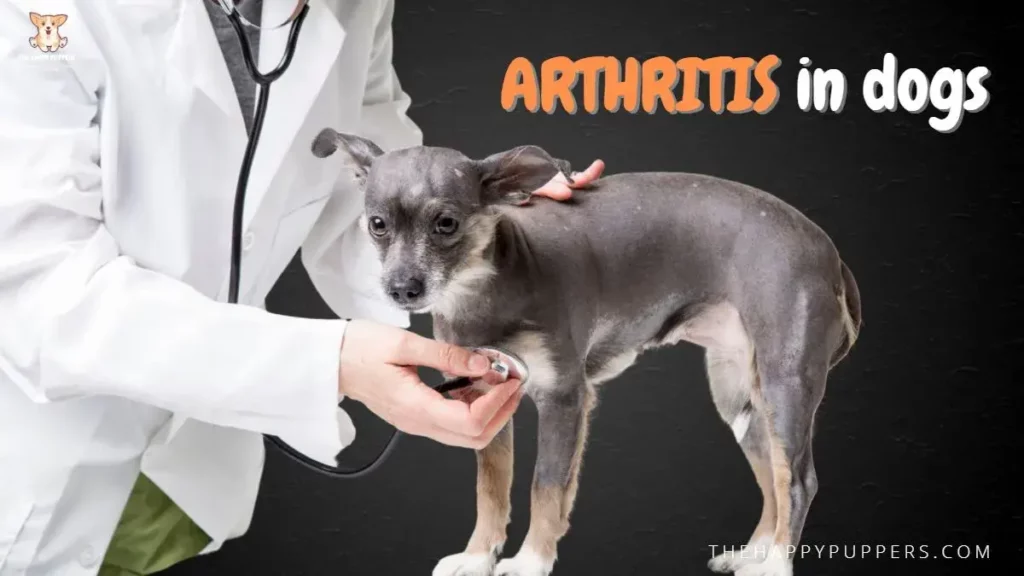Topics covered in this blog post
Arthritis in dogs: what you need to know to make your dog’s life healthier
By now you must have heard about arthritis affecting humans. However, have you heard about arthritis in dogs as well? The reality is that one in every five dogs experience arthritis in their lifetime. Arthritis has been observed to most often affect senior dogs however it is not exactly restricted to the older ones. It can affect younger dogs as well.
What is arthritis?
In the simplest of explanation, arthritis means inflammation of the joints. Arthritis is a common problem in a lot of dog breeds like Labradors, Great Danes etc. The textbook symptoms of arthritis are
- Discomfort
- Stiffness in the joint
- Pain
Inside the joints of a dog, the surface of the bone is covered with a thin layer of cartilage. The cartilage is covered with joint fluid that allows the two surfaces to freely glide over one another with the least amount of friction. If you dog is suffering from arthritis, the cartilage within the joints get damaged or undergo changes, reducing the fluidity of the cartilage and causing the two surfaces of the bone to rub against each other. Due to this increased friction, there is new bone formation around the joint, making the joints stiffer and limiting the movement of your dog. This condition is referred to as degenerative joint disease.
What are the causes behind arthritis?
Arthritis occurs most often as a result of abnormal rubbing within the joints which is a result of joint instability. For example, ligament damage, abnormal cartilage development, cartilage damage or damage due to some kind of trauma example fractures. The signs of arthritis can be variable throughout the life of the animal and can lead to the knee or joint problems in adult dogs.
What are the signs of arthritis in dogs?
The most common sign that your dog is suffering from arthritis are:
- Walking with a stiff gate
- Difficulty getting up and down
- Reluctance to climb up or down the stairs
- Stiff sore or swollen joints
- Reluctance to jump
- Reduction in stamina
- Increased aggression towards other dogs or towards humans
- Reluctance to be touched at certain parts of the party
- Joint stiffness improves with exercise
- Damp local conditions worsen the symptoms
- Continuous leaking at a specific spot (a joint that might be swollen)
- Generally being slow and grumpy
Understand the symptoms of pain in dogs
How is arthritis diagnosed in dogs?
Normally your veterinarian will be able to diagnose if your dog is suffering from arthritis by a physical examination and flexion and extension of the joints. Further examinations might include blood tests, uterine examination, CT scan or x-rays, joint fluid connection. Your vet will also assess your dog’s response towards the anti-inflammatory (administration of NSAIDs) treatment.
If this level of care is not available or affordable, your dog’s arthritis can still be diagnosed with a certain level of accuracy as the most common signs are reduced activity level, swelling, pain and restriction in movement of one or more joints and finally by identifying changes in the way your dog walks/ sits/lays.
Treatment of arthritis in dogs
If your dog is suspected to be suffering from arthritis, he or she might need treatment on many occasions during his/her lifetime. The treatment can vary in terms of the medication as well as the timescale depending on the patient.
Mainly three families of drugs are used for the treatment of canine arthritis:
Cartilage protectors
Cartilage protectors are drugs which are specifically designed to reduce the damage to the cartilage which is seen in this degenerative disease. These drugs include hyaluronic acid, pentosan polysulphates and polysulphated glycosaminoglycans. These drugs can reduce the degeneration of the cartilage as well as promote the repair of the joints and reduce inflammation.
Joint supplements
Joint supplements can be administered along with prescription medicines.
Anti-inflammatory drugs [NSAIDs]
This is the final drug which is used for treatment of arthritis in dogs. These are good for quick pain relief. However, these drugs have some serious side effects if used for a long time. They are a good choice for short-term pain management but long-term other options should be looked into. Understand the full effects of these anti-inflammatory drugs.
Secondly therapies
Acupuncture
Acupuncture is the procedure of insertion of needles into skin at specific regions of the body. There is clinical evidence which supports the acupuncture along with multimodal therapy can reduce the chronic joint pain observed in dogs in case of arthritis. Always speak to your veterinarian before determining if acupuncture is a good therapy option for your dog.
What can you DO to help your dog?
Control his/her weight as well as diet
More the weight, higher is the pressure on the joint. If your dog is overweight or has weight issues, get the weight under control as losing some of the rate relieve the pressure in the joints. You can also add supplements like omega-3 fatty acids chondroitin sulfate as well as glucosamine to his or her diet as these increase the lubrication of the joints and will help in mobility using the pain.
Use a soft mattress
The orthopedic beds made with memory foam which are specifically made for your dog. These beds will help support the joints and bones of your dog. This will provide relief to the arthritic bones and help them sleep more peacefully.
Installs slip free flooring, cubes and ramps.
Senior dogs or dogs with arthritis can have a very difficult time navigating hardwood or tile floors as well as stairs. You can use cubes or arms to help your dog climb up and down the stairs or the sofas. Placing carpets or rugs over slippery floors help your dog walk steadily and prevent slippage.
Give your dog lots of massage and moderate exercise
A good massage therapy can relieve the pain in your dog’s joints. It can also help improve your dog’s flexibility, mobility, circulation and provide a good night’s sleep. Gently knead your dog’s stiff muscles. Do not put any kind of direct pressure on the joint, this can be painful. You can also schedule an appointment with a massage therapist.
Regular exercise even if done in small amounts, can help strengthen the ligaments and muscles of your dog. It also reduces the risk of injury and fractures.
Grooming your dog
Dogs suffering from arthritis cannot clean themselves very well, especially in the regions which are hard to reach. Thus, if your dog is suffering from arthritis or if you have a senior dog, you should groom him or her more often than younger dogs. Brushing your dog’s hair regularly will get rid of the tangles and mats and make your dog feel better. Always remember to be gentle.
Food
Give foods like papaya, celery, ginger and alfalfa. These foods are good for dogs suffering from arthritis.
Raise the food and water bowls. This will reduce the strain on your dog’s neck or on the back. Some arthritis dogs may reduce eating and drinking due to the pressure it puts on their back. However, this type of arrangement can cause your dog to bloat. Consult with your veterinarian if your dog has bloating tendency.
Hydrotherapy
A lot of vet clinic as well as hospitals are recommending hydrotherapy or water treatment for arthritic dogs now. The most common therapy in use is the underwater treadmill. This is becoming the treatment of choice for dogs were recovering from surgery or suffering from joint problems. Water tends to increase the buoyancy, removing the pressure from the affected joints. This means moving in water easier and much less painful. Keeping the arthritic joints mobile and maintaining a healthy range of motion on a regular basis are the primary aims of treatment.
What you should NOT DO:
- Do not try to self diagnose your dog. Always consult your vet.
- Do not enforce any kind of exercise regimen your dog which he or she might not be comfortable with.
- Do not try to stretch your dog teams without proper training. Do not try to discontinue exercise. A limited amount of exercise gives the joint mobile and flexible.
- Do not try to ignore the extra weight of your dog more the weight more the pressure in the joint and more the joints are likely to suffer from fracture or pain. Do not ignore if your dog falls or slides. Continue swelling and sliding can be extremely damaging on arthritis dog’s body.
- Do not try to get any kind of medication without prior veterinary approval.
- Do not administer any human pain medication to your dog.
Conclusion
Have you had any experience with an arthritis dog? What did you do in such a situation? If you have any specific do’s or don’ts you would like to add, please mention it in the comment section below. If you want to know about home remedies which can help an arthritic dog, stay tuned for my next blog post.
Thank you for reading…
Other articles you might find interesting:
- Herbal remedies for pain management in dogs PART II
- Herbal remedies for pain management in dogs (PART I)
See you in my next blog post
Shruti



3 Comments
As a Newbie, I am continuously browsing online for articles that can benefit me. Thank you
I agree with your point of view, your article has given me a lot of help and benefited me a lot. Thanks. Hope you continue to write such excellent articles.
Reading your article helped me a lot and I agree with you. But I still have some doubts, can you clarify for me? I’ll keep an eye out for your answers.